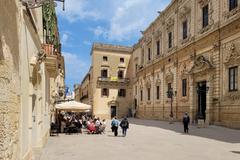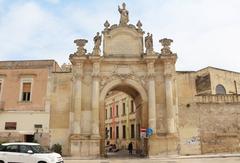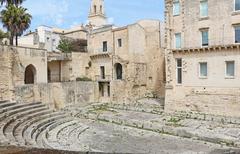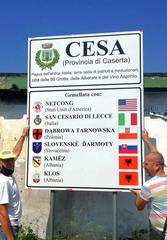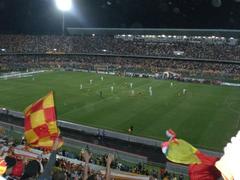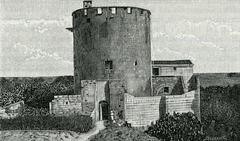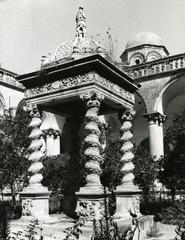Rudiae Amphitheatre: Visiting Hours, Tickets, and Historical Insights in Lecce, Italy
Date: 14/06/2025
Introduction
The Rudiae Amphitheatre, located just outside Lecce in southern Italy’s Apulia region, is an archaeological gem offering a compelling window into the ancient Messapian and Roman civilizations. Set within the Parco Archeologico di Rudiae, the amphitheatre invites visitors to explore the remnants of a city that once thrived as a cultural and commercial crossroads in the Mediterranean. This comprehensive guide provides essential information on visiting hours, ticketing, accessibility, historical background, and practical tips to help you make the most of your visit to Rudiae and its surrounding sites (Comune di Lecce, SpottingHistory, Puglia Everyday).
Table of Contents
- Historical Overview
- Visiting the Rudiae Amphitheatre
- Guided Tours, Special Events, and Educational Resources
- Nearby Attractions and Cultural Itineraries
- Preservation Challenges and Sustainable Tourism
- Future Developments and Strategic Vision
- FAQ
- Practical Tips for Your Visit
- References and Further Reading
Historical Overview
Messapian Roots
Rudiae’s history begins with the Messapians, an Italic people who settled in the Salento peninsula around the ninth or eighth centuries BCE. The city became a prominent urban center, as evidenced by extensive fortification walls—some up to 8 meters thick—constructed using the opus quadratum technique. Archaeological discoveries include a necropolis with Messapian inscriptions and funerary pottery, reflecting Rudiae’s status as a major center for both defense and craftsmanship (SpottingHistory).
Roman Transformation and Architecture
Following Roman conquest, Rudiae integrated into the Roman urban network, shifting from a Messapian stronghold to a city shaped by classical influences. The amphitheatre itself dates to the early Imperial period—likely between the late 1st and early 2nd centuries CE. It features an elliptical plan, a cavea (seating area), vomitoria (corridors), and substructures built from local limestone and tuff. Inscriptions and architectural evidence indicate restorations during Commodus’ reign (180–192 CE), and the remains suggest a capacity for several thousand spectators (Futuracom PDF).
Amphitheatre’s Social Role
Like amphitheatres throughout the Roman Empire, Rudiae’s served as a venue for gladiatorial combats, animal hunts, and public spectacles. These events reinforced social hierarchies and imperial power, forming a central aspect of community life. Artistic depictions of animals such as bulls and lions on site underscore the variety of spectacles held here (Futuracom PDF).
Medieval Decline and Rediscovery
With the fall of the Roman Empire, the amphitheatre fell into disuse and, by the 13th–14th centuries, was repurposed as a quarry. Limestone blocks from the site were used in building projects in Lecce, contributing to the partial burial and destruction of the original structure. The amphitheatre remained largely forgotten until renewed archaeological interest in the late 19th and 20th centuries led to documentation and early excavations (Futuracom PDF).
Modern Archaeology and Preservation
Systematic excavations since 2011, supported by the Municipality of Lecce and the University of Salento, have revealed much of the arena and cavea, clarified architectural phases, and enabled significant conservation work. The amphitheatre is now a centerpiece of the Parco Archeologico di Rudiae, offering interpretive trails and educational resources for visitors (Comune di Lecce, Parco Archeologico Rudiae).
Visiting the Rudiae Amphitheatre
Visiting Hours
- Tuesday to Sunday: 9:00 AM – 7:00 PM (April–October); 9:00 AM – 5:00 PM (November–March)
- Closed: Mondays and major public holidays
- Note: Hours may vary due to restoration, holidays, or special events. Always confirm via the official website before your visit.
Ticket Information
- Adults: €6–€8
- Reduced (students, seniors, EU citizens 18–25): €3–€5
- Children under 12/18 and Lecce residents: Free
- Guided Tours: Available for an additional fee (€10 per group on request)
- Where to Buy: Tickets can be purchased onsite or online via the Comune di Lecce website or Castello di Lecce portal.
Accessibility
- The site features paved and gravel paths, with partial accessibility for visitors with limited mobility. Some uneven terrain and steps are present; contact the site in advance for assistance.
- Restrooms and a small visitor center are available at the entrance.
- Future enhancements are planned to further improve accessibility and inclusivity.
Getting There
- By Car: 5–10 minutes from Lecce’s city center; parking available near the park entrance.
- By Public Transport: Local buses run from Lecce’s main station; tourist train services are available in high season.
- By Bicycle/On Foot: Scenic routes available from Lecce; ideal in mild weather.
- Address: Parco Archeologico di Rudiae, Via San Pietro in Lama, 73100 Lecce, Italy
Visitor Facilities and Site Etiquette
- The site includes informational panels, maps, and occasional exhibitions.
- There are no cafés or restaurants on-site; bring water and snacks.
- Photography for personal use is allowed; tripods and drones require permission.
- Please do not climb on ruins, touch artifacts, or smoke within the archaeological area.
Guided Tours, Special Events, and Educational Resources
- Guided Tours: Available in multiple languages and can be booked online or at the Carlo V Castle infopoint in Lecce (Castello di Lecce).
- Audio Guides: Rentable onsite for self-guided exploration.
- Events: The amphitheatre hosts concerts, reenactments, and workshops, especially during summer. Event details are updated on the Comune di Lecce tourism website.
- Educational Materials: Onsite signage, brochures, and activity sheets for children enhance the visitor experience.
Nearby Attractions and Cultural Itineraries
- Roman Amphitheatre of Lecce: Located in Piazza Sant’Oronzo, this centrally situated amphitheatre is a highlight of Lecce’s Roman past.
- Baroque Architecture: Explore Lecce’s historic center, including the Basilica di Santa Croce and Piazza del Duomo (Beautiful Puglia).
- Other Sites: Castello Carlo V, Porta Rudiae, and the Sigismondo Castromediano Museum, which showcases Messapian and Roman artifacts.
- See also: Lecce historical sites, Roman Amphitheatre in Lecce, Salento’s archaeological heritage
Preservation Challenges and Sustainable Tourism
- Archaeological Constraints: Much of the amphitheatre remains unexcavated due to urban encroachment and resource limitations.
- Environmental Risks: The porous local stone is vulnerable to erosion, requiring ongoing maintenance.
- Tourism Management: With millions visiting Lecce annually, sustainable measures are in place to distribute visitor flow and protect fragile sites. Rudiae’s promotion helps relieve pressure on more famous monuments and supports local employment.
Future Developments and Strategic Vision
- Planned Excavations: Ongoing projects aim to uncover more of the amphitheatre and associated Roman buildings.
- Infrastructure Upgrades: New visitor facilities, digital guides, and tactile exhibits are planned to enhance accessibility.
- Cultural Integration: The site is increasingly used for cultural programming, blending archaeological heritage with contemporary events.
- Legislative Support: Regional initiatives such as the “Lecce Romana” law aim to secure funding and streamline preservation for Lecce’s ancient sites.
FAQ
Q: What are the Rudiae Amphitheatre visiting hours?
A: Tuesday to Sunday, 9:00 AM–7:00 PM (summer), 9:00 AM–5:00 PM (winter); closed Mondays. Check official sources for updates.
Q: How much do Rudiae Amphitheatre tickets cost?
A: €6–€8 for adults, with discounts for students, seniors, and children under 12/18. Children under 6 typically enter free.
Q: Is the amphitheatre wheelchair accessible?
A: The site has partial accessibility; some areas have uneven ground. Call ahead for assistance.
Q: Are guided tours available?
A: Yes, bookable online or at the Carlo V Castle infopoint; audio guides also available.
Q: Can I take photographs inside the amphitheatre?
A: Yes, for personal use. Tripods and drones require advance permission.
Practical Tips for Your Visit
- Best Visiting Times: Early morning or late afternoon; spring and autumn offer mild weather and fewer crowds.
- What to Bring: Comfortable shoes, water, sun protection, and a camera.
- Combine Your Visit: Include Lecce’s Baroque landmarks, the Roman Theatre, and local museums for a comprehensive historical itinerary.
- Safety: Watch for uneven terrain and supervise children at all times.
References and Further Reading
- Comune di Lecce, Official Tourism Portal
- SpottingHistory, Rudiae Archaeological Site Overview
- Futuracom, Rudiae Amphitheatre Archaeological Report
- Puglia Everyday, Travel Guide to Lecce
- Parco Archeologico Rudiae, Guided Tours and Information
For the latest events, updates, and immersive digital resources—including audio tours—download the Audiala app and follow Lecce’s cultural channels on social media.
